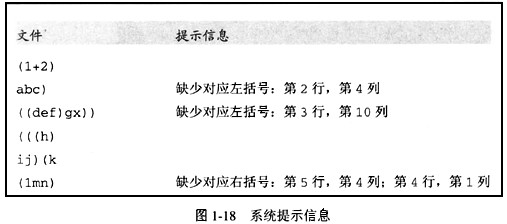阅读以下程序说明和C++程序,将程序段中(1)~(5)空缺处的语句填写完整。
【说明】
以下【C++程序】实现一个简单的小型复数类MiniComplex,该复数类能进行输入、输出、复数的加法、减法、乘法和除法运算,还可以进行复数的相等比较。
【C++程序】
#ifndef H_MiniComplex
#define H_MiniComplex
#include <iostream>
using namespace std;
class MiniComplex{
public: //重载流插入和提取运算符
(1) ostream&operator<<(ostream &osObject,const MiniComplex&complex){
osObject<<"("<<complex.realPart<<"+"<<complex.imagPart<<"i"<<")";
return osObject;
}
(2) istream&operator>>(istream&isObject, MiniComplex&complex){
char ch;
isObject >>complex.realPart>>ch>>complex.imagPart>>ch;
return isObject;
}
MiniComplex(double real=0,double imag=0); //构造函数
MiniComplex operator+(const MiniComplex&otherComplex)const; //重载运算符+
MiniComplex operator-(const MiniComplex&otherComplex)const; //重载运算符-
MiniComplex operator*(const MiniComplex&otherComplex)const; //重载运算符*
MiniComplex operator/(const MiniComplex&otherComplex)const; //重载运算符/
bool perator==(const MiniComplex&otherComplex)const; //重载运算符==
private :
double (3);
double imagPart;
};
#end if
#include "MiniComplex.h"
bool MiniComplex::operator==(const MiniComplex&otherComplex)const{
return(realPart==otherComplex.realPart&&imagPart==ortherComplex.imagPart);
}
MiniComplex::MiniComplex(double real,double imag){
realPart== real; imagPart==imagPart;
}
MiniComplex MiniComplex::operator+(const MiniComplex&otherComplex)const{
MiniComplex temp;
temp.realPart = realPart+ortherComplex. realPart;
temp.imagPart = imagPart +ortherComplex. imagPart;
return temp;
}
(4)
{ MiniComplex temp;
temp.realPart= realPart-ortherComplex. realPart;
temp.imagPart = imagPart-ortherComplex. imagPart;
return temp;
}
MiniComplex MiniComplex::operator*(const MiniComplex&otherComplex)const{
MiniComplex temp;
temp.realPart = (realPart*ortherComplex. realPart)-(imagPart *ortherComplex.imagPart);
temp.imagPart = (realPart*ortherComplex. imagPart)+(imagPart *ortherComplex.realPart);
return temp;
}
MiniComplex MiniComplex::operator/(const MiniComplex&otherComplex)const{
MiniComplex temp;
float tt;
tt=1/(ortherComplex.realPart*ortherComplex.realPart+ortherComplex.imagPart *ortherComplex. imagPart);
temp.realPart=((realPart*ortherComplex, realPart)+(imagPart *ortherComplex. imagPart))*tt;
temp.imagPart =((imagPart *ortherComplex. realPart)-(realPart*ortherComplex. imagPart))*tt;
return temp;
}
#include <iostream>
#include <MiniComplex.h>
using namespace std;
int main(){
MiniComplex numl(23, 34),num2(56, 35);
cout<<"Initial Value of num1="<<num1<<"\n Initial Value of num2="<<num2<<end1;
cout<<num1<<"+"<<num2<<"="<<num1+num2<<end1; //使用重载的加号运算符
cout<<num1<<"-"<<num2<<"="<<num
-
阅读以下关于某订单管理系统的技术说明、部分UML类图及Java程序,将Java程序中(1)-(5)空缺处的语句填写完整。
[说明]
某订单管理系统的部分UML类图如图3-21所示。

图3-21 某订单管理系统的部分分类图
在图3-21中,Product表示产品,ProductList表示所销售产品的列表,Order表示产品订单,OrdeItem表示产品订单中的一个条目,OrderList表示订单列表,SalesSystem提供订单管理系统的操作接口。各个类的部分属性和方法说明如表3-16所示。

可以使用类java.util.ArrayList<E>来实现对象的聚集关系,如图3-21所示OrderList与Order之间的聚集关系。
For...each循环提供了一种遍历对象集合的简单方法。在for...each循环中,可以指定需要遍历的对象集合及用来接收集合中每个元素的变量,其语法如下:
for(用来接收集合中元素的变量:需要遍历的对象集合)
如果要使用for-each循环来遍历对象集合,那么包含该对象集合的类必须实现接口java.util.Iterable<T>。
[Java程序7-1]和[Java程序7-2]分别给出了类OrderList和方法statistic的Java代码。
[Java程序7-1]
import java.util.*.
public class OrderList (1) {
private ArrayList<Order> orders;
public OrderList() {
this.orders = new ArrayList(Order)"();
}
public void addOrder(Order order) {
this.orders, add (order);
}
public Iterator<Order> iterator() {
return (2);
}
public int getNumberOfOrders() {
return this.orders, size();
}
}
[Java 程序7-2]
import java.util.*;
public class SalesSystem {
private ProductList catalog;
private OrderList sales;
private static PrintWriter stdOut = new PrintWriter(System.out, true);
public void statistic() {
for (Product product :(3) {
int number = 0;
for (Order order :(4) {
for ( (5): order) {
if<product.ecluals(item.getProduct()))
number += item.getQuantity() ;
}
}
stdOut.println(product.getCode() + " " + product.getDescription() + " " + number + " " + number *product.getPrice());
}
}
//其余的方法未列出
}
-
阅读以下程序说明和C++程序,将程序段中(1)~(5)空缺处的语句填写完整。
【说明】
以下【C++程序】实现一个简单的小型复数类MiniComplex,该复数类能进行输入、输出、复数的加法、减法、乘法和除法运算,还可以进行复数的相等比较。
【C++程序】
#ifndef H_MiniComplex
#define H_MiniComplex
#include <iostream>
using namespace std;
class MiniComplex{
public: //重载流插入和提取运算符
(1) ostream&operator<<(ostream &osObject,const MiniComplex&complex){
osObject<<"("<<complex.realPart<<"+"<<complex.imagPart<<"i"<<")";
return osObject;
}
(2) istream&operator>>(istream&isObject, MiniComplex&complex){
char ch;
isObject >>complex.realPart>>ch>>complex.imagPart>>ch;
return isObject;
}
MiniComplex(double real=0,double imag=0); //构造函数
MiniComplex operator+(const MiniComplex&otherComplex)const; //重载运算符+
MiniComplex operator-(const MiniComplex&otherComplex)const; //重载运算符-
MiniComplex operator*(const MiniComplex&otherComplex)const; //重载运算符*
MiniComplex operator/(const MiniComplex&otherComplex)const; //重载运算符/
bool perator==(const MiniComplex&otherComplex)const; //重载运算符==
private :
double (3);
double imagPart;
};
#end if
#include "MiniComplex.h"
bool MiniComplex::operator==(const MiniComplex&otherComplex)const{
return(realPart==otherComplex.realPart&&imagPart==ortherComplex.imagPart);
}
MiniComplex::MiniComplex(double real,double imag){
realPart== real; imagPart==imagPart;
}
MiniComplex MiniComplex::operator+(const MiniComplex&otherComplex)const{
MiniComplex temp;
temp.realPart = realPart+ortherComplex. realPart;
temp.imagPart = imagPart +ortherComplex. imagPart;
return temp;
}
(4)
{ MiniComplex temp;
temp.realPart= realPart-ortherComplex. realPart;
temp.imagPart = imagPart-ortherComplex. imagPart;
return temp;
}
MiniComplex MiniComplex::operator*(const MiniComplex&otherComplex)const{
MiniComplex temp;
temp.realPart = (realPart*ortherComplex. realPart)-(imagPart *ortherComplex.imagPart);
temp.imagPart = (realPart*ortherComplex. imagPart)+(imagPart *ortherComplex.realPart);
return temp;
}
MiniComplex MiniComplex::operator/(const MiniComplex&otherComplex)const{
MiniComplex temp;
float tt;
tt=1/(ortherComplex.realPart*ortherComplex.realPart+ortherComplex.imagPart *ortherComplex. imagPart);
temp.realPart=((realPart*ortherComplex, realPart)+(imagPart *ortherComplex. imagPart))*tt;
temp.imagPart =((imagPart *ortherComplex. realPart)-(realPart*ortherComplex. imagPart))*tt;
return temp;
}
#include <iostream>
#include <MiniComplex.h>
using namespace std;
int main(){
MiniComplex numl(23, 34),num2(56, 35);
cout<<"Initial Value of num1="<<num1<<"\n Initial Value of num2="<<num2<<end1;
cout<<num1<<"+"<<num2<<"="<<num1+num2<<end1; //使用重载的加号运算符
cout<<num1<<"-"<<num2<<"="<<num
-
若要在图4-16窗口内新增一个[帮助]按钮,单击该按钮就会弹出一个帮助对话框(另一名为frm002的窗体),用户必须在其中做出响应,程序才能继续运行。请将以下该命令按钮的单击事件过程中的程序代码填写完整。
Private Sub CmdHelp_C1ick()
(10)
End Sub
-
阅读以下应用说明及Visual Basic程序,根据要求回答问题1至问题2。
[说明]
某Visual Basic应用程序用于监测某种锅炉设备内液面高度(0~50cm),其运行窗口界面如图4-16所示。

图4-16 某锅炉设备液面高度显示界面
在图4-16中,设计了一个高度计(矩形形状shpMeter)及其中指示当前液面高度的水银柱(矩形形状shpT),文字标签标记了液面高度的刻度;另有一个图片框picCurve,用于动态描述检测到的液面高度曲线(用户见到的曲线与水银柱等高变化);[开始](CmdStart)按钮用于启动液面高度检测,命令按钮“暂停”(CmdStop)用于暂停液面高度检测。
液面高度计形状控件shpMeter是固定的,其属性FillsStyle默认为透明。矩形形状shpT(水银柱)的 Visible属性初始设置为不可见,属性Filltype设置为Solid(实心),FillColor设置为红色;图片框picCurve的属性AutoRedraw设置为True;程序设计过程中,创建了一个定时器TimT,属性Enabled初始设置为 False(不可用),属性Interval(定时间隔)的值应设置为(1)。
为模拟锅炉设备液面高度的检测,程序中利用了(0,1)之间均匀分布的伪随机数获得[0,50]之间的随机液面高度WH。为便于在图片框picCurve中绘制曲线,程序中对该图片框建立了如下坐标系统:图片框的左上角定义为原点(0,0),水平向右方向为X轴,垂直向上方向为Y轴,右下角坐标为(50.200)。为了便于观察记录的液面高度值,图片框中从上到下创建了7条水平虚线Ls(i),i=0,1…6,并在程序中按等间隔排列进行位置设置。应用程序中每隔3秒算出曲线点(x, y),其中x=O,1,2……,再用直线段连接各相邻曲线点形成液面高度曲线。
[Visual Basic程序代码]
Dim (2) AS Integer '试题全局变量
Private Sub CmdStart_Click()
TimT.Enabled =(3)
ShpT.Visible = True
End Sub
Private Sub CmdStop_Click()
TimT.Enabled = False
End Sub
Private Sub Form_Load( )
Dim i,S As Integer
PicCurve.Scale (0,0)-(50,200) '设置图片框坐标系:左上角-右下角
S = 25 'H等于图片框高度的1/8
For i = 0 To 6 '设置7条水平线Ls(i)的位置
Ls(i).X1 = 0 'Ls(i)起点横坐标
Ls(i).Y1 =(4) 'Ls(i)起点纵坐标
Ls(i).X2 = 50 'Ls(i)终点横坐标
Ls(i).Y2 = Ls(i).Y1 'Ls(i)终点纵坐标
Ls(i).BorderColor = &H00FCFCFC '设置水平线颜色
(5)
x = 0 '设置曲线坐标初值
End Sub
Private Sub timT_Timer ( )
Dim WH, H As Integer 'WH为实时液面高度,H为图片框中液面高度点显示高度
WH = Int(Rnd * 51) '随机模拟产生锅炉内液面高度(0~50 cm)
H = ShpMeter.Height * (6) '算出水银柱的高度
ShpT.Top =(7) '设置水银柱顶部位置
ShpT.Height = H '设置水银柱的高度
'绘制液面高度曲线
y =(8) '算出曲上当前点的纵坐标
If x = 51 Then '当超出图片框时
PicCurve. Cls '清框图片框内以前画的曲线
(9)
ElseIf x > 0 Then '除左边点外
PicCurve. Line (x-1,Lasty)-(x,y),vbRed '由前1点到当前点画红色线段
End If
x = x + 1 '准备下一点坐标
Lasty = y '保存当前坐标供下次使用
End Sub
请根据[说明]和图4-16所示的显示结果,将[说明]中(1)空缺处的内容和[Visual
-
请从以下选项中选择相应的判断逻辑填写【算法4-2】中的“判断条件1”至“判断条件3”。注意,如“判断条件2”的逻辑判断结果为假,则无须对“判断条件3”进行判断。 判断条件1:(8) 判断条件2:(9) 判断条件3:(10) 【供选择的答案】A.栈顶元素表示的是与当前字符匹配的左括号
B.栈顶元素表示的是与当前字符匹配的右括号
C.字符是左括号
D.字符是右括号
E.栈不空F.栈空G.字符是括号
-
阅读以下算法说明和C程序,根据要求回答问题1和问题2。
【说明】
【算法4-1】的功能是用来检查文本文件中的圆括号是否匹配。若文件中存在圆括号而没有对应的左括号或者右括号,则给出相应的提示信息,如图1-18所示。

在【算法4-1】中,slack为一整数栈。算法中各函数的说明如表1-11所示。

【算法4-1】
将栈stack置空,置EOF为false
Ch<-nextch();
while(not EOF)
k←kind(ch);
if (k ==(1) ) {
push( (2) );
push( (3) );}
else if( k ==(4) )
if(not empty()){
pop();
pop();)
else{
显示错误信息(缺少对应左括号或右括号):
显示行号row:显示列号col:)
End if
End if
Ch<-nextch();
end while
if(not empty())
显示错误信息(缺少对应左括号或右括号):
While(not empty()){
row<-pop();
col<-pop():
显示行号row:显示列号col;)
End while
End if
为了识别更多种类的括号,对【算法4-1】加以改进后得到【算法4-2】。【算法4-2】能够识别圆括号、方括号和花括号(不同类型的括号不能互相匹配)。改进后,函数kind(charch)的参数及其对应的返回值如表1-12所示。

【算法4-2】
将栈stack置空,置EOF为false
Ch<-nextch();
while(not EOF){
k<- kind(ch);
if(k > 0)
if(判断条件1){
push( (5) );
push( (6) );
push( (7) );}
else if(判断条件2 and判断条件3){
pop();
pop();
pop();}
else {
显示错误信息(缺少对应左括号或右括号);
显示行号row;显示列号col;)
end if
end if
ch <- nextch();)
end while
if(not empty()){
显示错误信息(缺少对应左括号或右括号);
While(not empty()){
Pop();
row <- pop():
col <- pop();
显示行号row;显示列号col;))
end while
end if
请将【算法4-1】和【算法4-2】中,(1)~(7)空缺处的内容补充完整。
-
该贪心算法的时间复杂度为(5)。
-
阅读以下应用程序说明和C程序,将C程序段中(1)~(7)空缺处的语句填写完整。
【说明】
以下【C程序】的功能是从文件text_01.ini中读入一篇英文短文,统计该短文中不同单词和它的出现次数,并按词典编辑顺序将单词及它的出现次数输出到文件word_xml.out中。
该C程序采用一棵有序二叉树存储这些单词及其出现的次数,一边读入一边建立。然后中序遍历该二叉树,将遍历经过的二叉树上节点的内容输出。
程序中的外部函数
int getword(FILE *fpt,char *word)
从与fpt所对应的文件中读取单词置入word,并返回1;若已无单词可读,即到文件尾部时,则函数返回0。
【C程序】
#include <stdio.h>
#include <malloc.h>
#include <ctype.h>
#include <string.h>
#define INF "TEXT_01.INI"
#define OUTF "WORD_XML.OUT"
typedef struct treenode {
char *word;
int count;
struct treenode *left, *right;
} BNODE;
int getword(FILE *fpt,char *word);
void binary tree(BNODE **t,char *word)
{ BNODE *ptr, *p;
int cmpres;
p = NULL;
(1);
while (ptr) { /*寻找插入位置*/
cmpres = strcmp(word, (2)); /* 保存当前比较结果*/
if (!cmpres) {
(3)
return;
}
else {
(4);
ptr = cmpres > 0 ? ptr->right : ptr->left;
}
}
ptr = (BNODE *)malloc(sizeof(BNODE));
ptr->right = ptr->left = NULL;
ptr->word = (char *)malloc(strlen(word)+1);
strcpy(ptr->word,word);
ptr->count = 1;
if (p == NULL)
(5) ;
else
if (cmpres > 0)
p->right = ptr;
else
p->left = ptr; }
}
void midorder(FILE *fpt, BNODE *t)
{ if ((6))
return;
midorder(fpt , t->left);
fprintf(fpt , " %s %d\n " , t->word , t->count);
midorder(fpt , t->right); }
void main()
{ FILE *fpt;
char word[40];
BNODE *root = NULL;
if ((fpt = fopen(INF , "r")) == NULL) {
printf("Can't open file %s\n",INF);
return;
}
while (getword(fpt,word) == 1)
binary_tree( (7) );
fclose(fpt);
fopen(OUTF,"w");
midorder(fpt, root);
fclose(fpt);
}
-
阅读以下技术说明和问题模型图,根据要求回答问题1和问题2。
【说明】
某大学城图书馆需要在无线阅览厅的某些位置上放置无线接入点AP(Access Poin)。假设每个无线AP覆盖范围的半径是6米,因此必须使得每台笔记本电脑上的无线网卡到某个无线AP的直线距离不超过6米。为了简化问题,假设所有无线网卡在同一直线上,并且无线AP沿该直线放置。该问题可以建模为如图1-16所示,其中直线表示无线网卡所在的直线,实心正方形表示无线网卡。现利用贪心策略实现用尽可能少的无线AP覆盖所有的无线网卡。

实现贪心算法的流程如图1-17所示。其中,①d[i](1≤i≤N)表示第i张无线网卡到通道A端的距离,N表示无线网卡的总数,无线网卡的编号按照无线网卡到通道A端的距离从小到大进行编号;②s[k]表示第k(k≥1)个无线AP到通道A端的距离。算法结束后k的值为无线AP的总数。

请填补图1-17流程图中(1)-(4)空缺处的内容。
-
阅读以下说明和流程图,将应填入(n)处的字句写在对应栏内。
[说明]
下面的流程图实现了正整数序列{K(1),K(2),…,K(n)}的重排,得到的新序列中,比K(1)小的数都在K(1)的左侧,比K(1)大的数都在K(1)的右侧。以n=6为例,序列{12,2,9,13,21,8}的重排过程为:
{12,2,9,13,21,8}
→{2,12,9,13,21,8}
→{9,2,12,13,21,8}
→{8,9,2,12,13,21}
[流程图]

高级经济师考试试题精选练习(1)
高级经济师考试模拟练习题之单选题(1
高级经济师考试试题精选练习(2)
高级经济师考试试题精选练习(3)
高级经济师考试试题:经济法案例试题精
高级经济师考试模拟试题及答案
高级经济师考试试题及答案:单选练习题
高级经济师考试试题:经济法案例试题精
高级经济师考试模拟题及答案练习(1)
高级经济师考试模拟题及答案练习(2)








